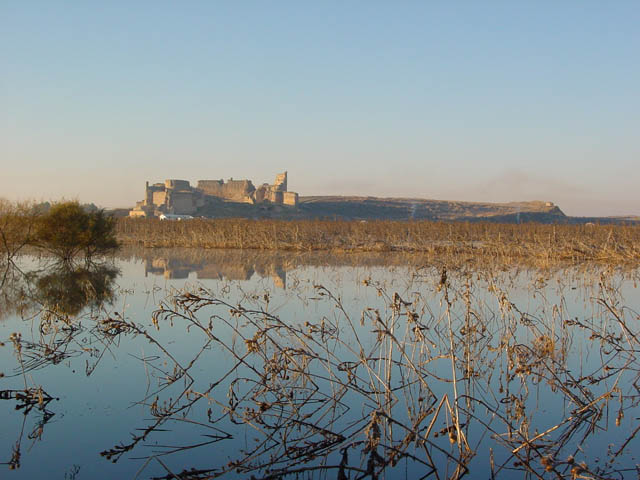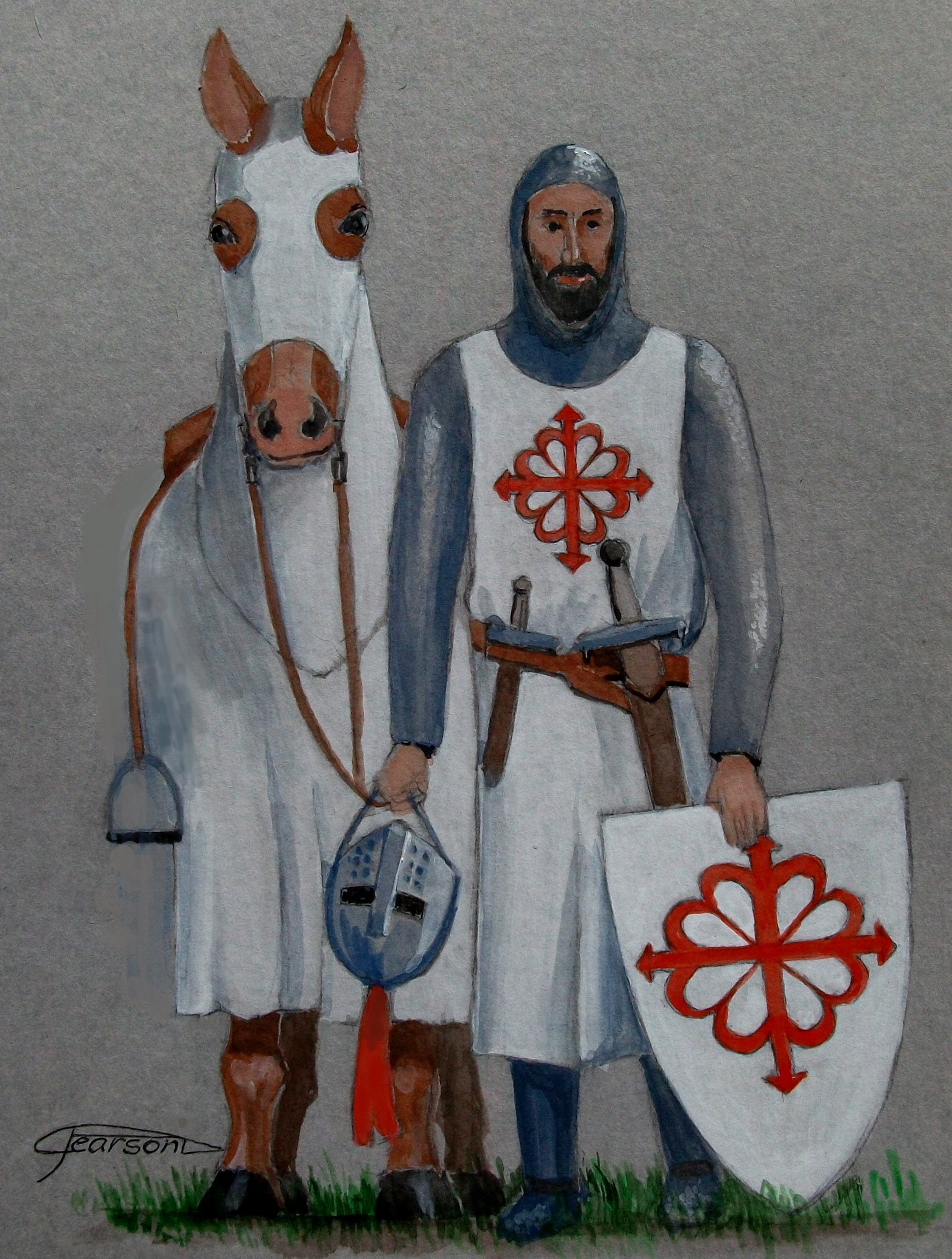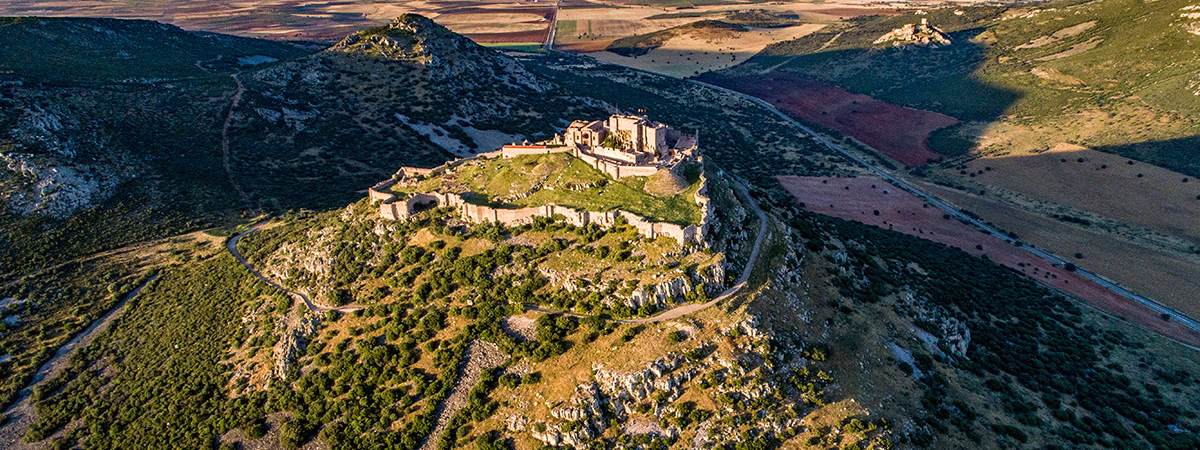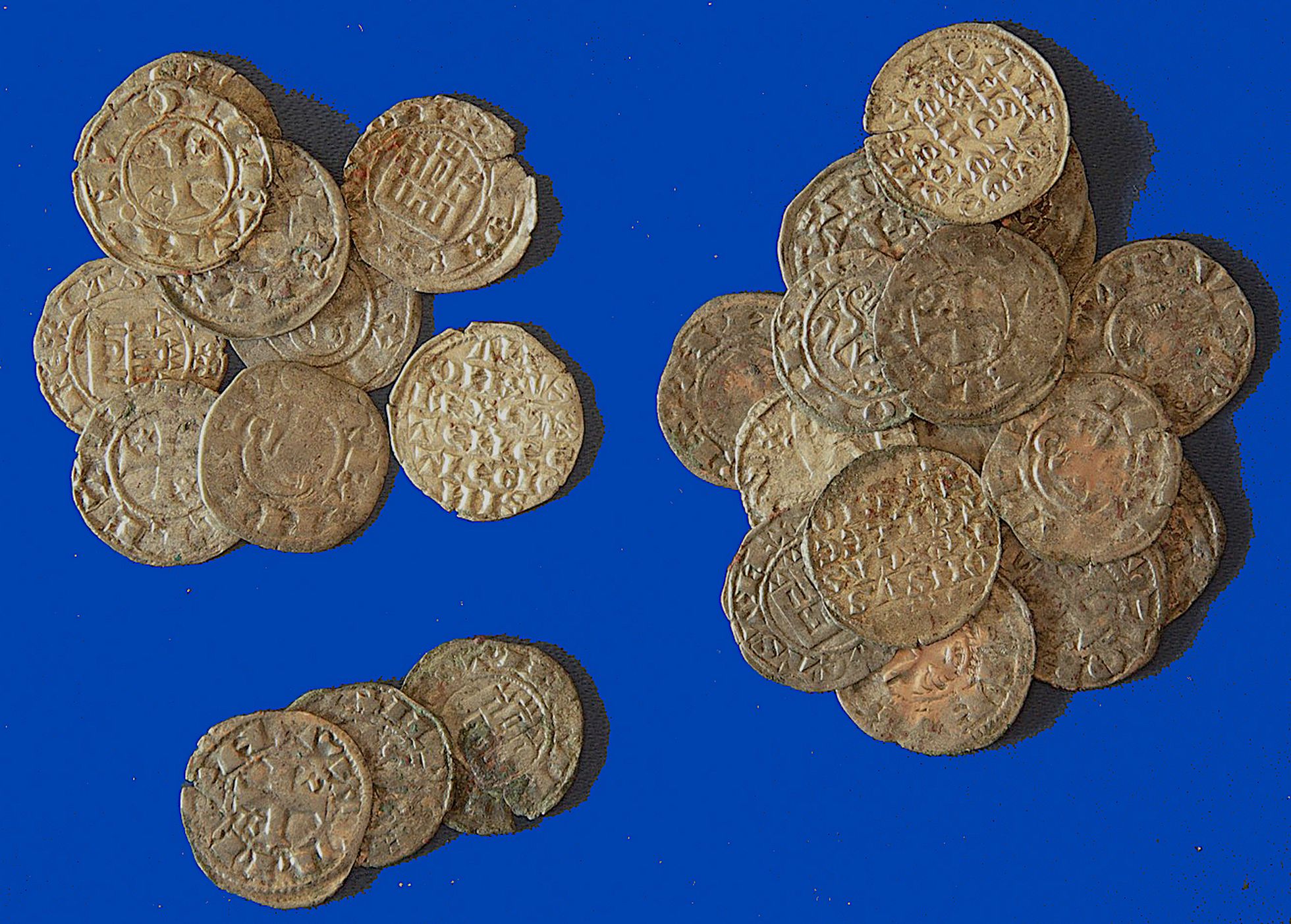For 400 years the walled fortress of Calatrava la Vieja stood on the frontier between Muslim and Christian lands. Its name was derived from the name of the Arab nobleman, Qalʿat Rabāḥ, who founded it sometime after 785. Towering over the Guadiana River valley, the fortress held great strategic importance by controlling the roads to the rival taifas of Córdoba and Toledo who fought each other and the taifa of Seville for its control. During these internal battles it was partially destroyed and rebuilt again by al-Hakam, son of Abd ar-Rahman II.

Calatrava la Vieja.
It was the Umayyad Caliphs of Córdoba who were in control of the fortress when it was attacked and captured by King Alfonso VII (el Emperador) in 1147, but it was at the extreme southern edge of the Christian kingdoms and it was inevitable that its ownership would be hotly contested. There is an old saying; you can have what you can take, but you can only keep what you can hold. This was true for the fortress of Calatrava. In those days there was no such thing as a standing army of troops who would defend the Christian kingdoms. Armies were raised on the offer of plunder and possible land gain for the dukes who were obliged to provide the king with men for a fixed term and to feed them. This was an onerous financial burden if you were only providing a garrison. However, the need for a unified force of soldiers during the reqonquista was obvious, and there was a precedent that had proved its worth and grown rich and powerful in the process..
When the First Crusade had captured Jerusalem from the Muslims in 1099 Christians flocked to make the pilgrimage to the Holy Land and Jerusalem. Higwaymen and bandits attacked these pious but wealthy pilgrims sometimes robbing and killing them by the hundreds. The point came when something had to be done to protect these innocent people, and it was a French knight who came up with the idea of creating a monastic order to protect the pilgrims. In 1119 Hugues de Payens approached King Baldwin II of Jerusalem and explained his idea. Early the following year at the Council of Nablus, Warmund, Patriarch of Jerusalem, granted the Frenchman his wish.
Initially the order was founded with just nine knights including Godfrey de Saint-Omer and André de Montbard. For a headquarters they were given a wing of the royal palace on the Temple Mount in the captured Al-Aqsa Mosque. The Temple Mount was believed to have been the site of the Temple of Solomon, and the new order became known as the Poor Knights of Christ and the Temple of Solomon, which was shortened to just the “Templars.” They had no financial backing and relied upon donations to survive. Their emblem was of two knights riding on a single horse, emphasizing the order's poverty.
Fifty years later, the Order of the Knights Templar had grown to a sizable army with quite impressive assets and funding, and it was they who were given the task of defending the captured fortress of Calatrava. For reasons unknown, the Templars did not stay long, and King Sancho III of Castile made a public offer to give the castle and surrounding land to any group who would defend it for him. This prompted a retired soldier called Diego Velásquez who had become a monk at the monastery of Fitero to speak to his abbot, Raymond. Cistercian monks were not warriors, so Diego proposed forming an army of defenders from the lay-brothers of the order. Lay-brothers were a recent addition to Cistercian monasteries which had found the need to allow tradesmen into their monasteries. Whilst the monks performed more pious duties, the lay-brothers looked after the cattle and sheep and maintained the buildings. They did not wear habits and had taken no religious vows, and must have been very happy that they had landed a plum job for life. Monasteries then were oases of sanity and safety whilst the hatred and brutality of the requonquista raged around them. When Diego suggested that they become Soldiers of the Cross they must have been overjoyed. However, the lay-brother loophole allowed Raymond to hire another kind of tradesmen, those who lived by the sword. Raymond went to his superior, Juan II of Toledo, the Archbishop of Toledo, who backed him to the hilt, creating the new Order of Calatrava in 1157. As it turned out, the first test for the order of would arrive the very next year.
The winds of change were blowing from Africa, and ten years earlier a new wave of Moors had subdued all of the Maghreb and crossed the straits into Iberia. The Almohads were a more orthodox Muslim sect who were determined to impose a stricter interpretation of the Koran on the Almoravids. In 1158 they made an attempt to take the fortress of Calatrava, but were beaten back by the Calatravans under the command of the Archbishop. The fortress remained under the control of the Calatravans for the next 36 years, but Raymond died in 1163 and was succeeded by a man whose history is unknown. Known only as Don Garcia, he must have been highly thought of by the king, who installed him as the first grand master of the order, forcing Velasquez into a secondary role. Garcia transformed the order into a private army. Under his rule, the monks were moved (under protest) to the monastery of Cirvelos, leaving just the knights under the command of Velasquez and a few other clerics to defend the fortress. The order attracted more mercenary knights and pious nobles willing to fund and fight the reqonquista. To give the order legitimacy with the church, and a formal code of conduct, a general chapter in 1187agreed upon the code for the Knights of Calatrava which was approved by Pope Gregory VIII. They were to be lay brothers following the Cistercian rules of silence in certain areas of the monastery, abstinence four days of the week, and to have several fast days during the year. More pertinent to their military role, they were to sleep in their armour and to wear the Cistercian white mantle with a black cross called the Flordelisada, which would later be changed to red.

A knight of the Order of Calatrava. Painting: A Pearson. alanpearson.pixels.com
Meanwhile, the power and forces of the Almohads had grown, and in 1195 they attacked the principle Christian town of town of Alarcos on the river Guadiana. King Alfonso VIII brought an army to the defence of the town, but he was defeated by Caliph Abu Yusuf Yaqub al-Mansur, who immediately began to occupy the surrounding territory. The first fortress to fall was Calatrava, and for the next seventeen years the frontier lay in the hills to the south of Toledo.
In 1212 Pope Innocent III called for a crusade against the Almohads, and the kingdoms rallied around his flag. The Catalans and Aroganese led by Peter II, the Franks led by the Archbishop of Narbonne and the Navarrese led by Sancho VII. The military orders also gave their support, including the Calatravans and Templars. The citadel of Calatrava was the first major objective to be recaptured followed by Alarcos and Benavente before the final battle at las Navas de Tolosa near Santa Elena, which broke the power of Muhammad al-Nasir and the Almohads.
But the story of Calatrava was not over. When the pope called for the crusade he assembled the troops of his coalition in Toledo where they immediately began to fall out with each other. The French and other Europeans were unused to the heat of the Iberian summer, but whilst they were camped around Toledo they were responsible for assaults and murders in the Jewish quarter of the town. When they took Calatrava, they wanted to slaughter the Jews and Moors who had lived in and defended the fortress and take their wives and children as slaves. Alfonso VIII had ordered the humane treatment of all the defenders and their families, as was common during the requonquista. This was not the kind of crusade the mercenary troops had signed up for and more than 30,000 men broke camp and deserted to cross back over the Pyrenees.
The final part of the story of the fortress of Calatrava came in 1217 when the frontier had been pushed back and the order moved 60 km to the south to the castle of Dueñas, which became known as Calatrava la Nueva, and the old Calatrava became known as Calatrava la Vieja.

Calatrava la Nueva
It’s one thing to read about history from dusty old books and piece together events from disjointed records, and another to be able hold the past in your hands.
In 1960 a farmer uncovered a buried stash of over 100 coins from the ninth century at what would then have been the eastern edge of Calatrava la Vieja. Archaeologists arrived on the scene too late to stop the farmer selling all but five coins, which he donated to the National Archaeological Museum in Madrid.
A second find came in 1995 during construction work close the first site, but this time the finder informed the Department of Pre-History, Archeology and Ancient History at Madrid’s Complutense University. The stash contained 400 grams of silver coins from the reigns of “all of the Umayyad Emirs of al-Andalus from Abd al-Rahman I to Abd Allah, plus a few fragments of Frankish coins, two coins from other Islamic dynasties and two small pieces of silver jewellery.” The chronology of the coins covers more than 100 years, from the late 700’s to 891 or 892 and they are now displayed Provincial Museum of Ciudad Real. A third find by archaeologists came in 2004 near to the alcázar fortress at Old Calatrava. 71 coins were uncovered by wrapped in fragments of cloth and had probably been hidden in the roof timbers of a house which collapsed sometime after 1217. The value of the coins is believed to have been around a month’s wages when they were hidden. A final find came in 2010 just eight meters from the previous one and contained 29 coins. These were minted between 1200 and 1264 and had also been hidden in the roof of a house.

The people who hid this money were hoping to return and collect it again, but in the uncertain and often brutal times in which they lived they often did not survive the frequent attacks and changes of ownership that plagued old Calatrava. Whole families would either be killed or sold into slavery as one warring faction replaced another.
The last part, including the photos of coins, is taken from an article in El Pais entitled Calatrava la Vieja’s hidden coins, and was authored by the archaeologist Manuel Retuerce Velasco and others.